Adetomyrma aureocuprea
| Adetomyrma aureocuprea | |
|---|---|

| |
| Scientific classification | |
| Kingdom: | Animalia |
| Phylum: | Arthropoda |
| Class: | Insecta |
| Order: | Hymenoptera |
| Family: | Formicidae |
| Subfamily: | Amblyoponinae |
| Tribe: | Amblyoponini |
| Genus: | Adetomyrma |
| Species: | A. aureocuprea |
| Binomial name | |
| Adetomyrma aureocuprea Yoshimura & Fisher, 2012 | |
Adetomyrma aureocuprea is only known from males. A. aureocuprea is completely sympatric with Adetomyrma bressleri, Adetomyrma caputleae, Adetomyrma goblin, and Adetomyrma venatrix, and was collected within a 20 km radius of Adetomyrma cilium and within a 70 km radius of Adetomyrma caudapinniger. The morphological differences between all species are clear and consistent in each case of sympatric and geographically close localities, even though apparent similarity may be shown to a character of another Adetomyrma species collected from distant localities. In addition to the above species, the distribution of A. aureocuprea is parapatric with Adetomyrma clarivida. (Yoshimura and Fisher 2012)
Identification
Yoshimura and Fisher (2012) - A. aureocuprea is easily separable from the other Adetomyrma males by the yellowish body color, no mesoscutal notaulus, poorly developed subpetiolar process, lack of posterodorsal projection or lobe on the paramere, short hairs on the compound eye, and vestigial parapsidal line.
The males of Adetomyrma aureocuprea display remarkable morphological variation in, for example, the size of the eye and ocelli, head shape, mesonotal shape, petiolar shape, and hairs on body surface.
Keys including this Species
Distribution
Latitudinal Distribution Pattern
Latitudinal Range: -12.52416667° to -25.59055556°.
| North Temperate |
North Subtropical |
Tropical | South Subtropical |
South Temperate |
- Source: AntMaps
Distribution based on Regional Taxon Lists
Malagasy Region: Madagascar (type locality).
Distribution based on AntMaps
Distribution based on AntWeb specimens
Check data from AntWeb
Countries Occupied
| Number of countries occupied by this species based on AntWiki Regional Taxon Lists. In general, fewer countries occupied indicates a narrower range, while more countries indicates a more widespread species. |

|
Estimated Abundance
| Relative abundance based on number of AntMaps records per species (this species within the purple bar). Fewer records (to the left) indicates a less abundant/encountered species while more records (to the right) indicates more abundant/encountered species. |

|
Biology
Castes
Male
Images from AntWeb
      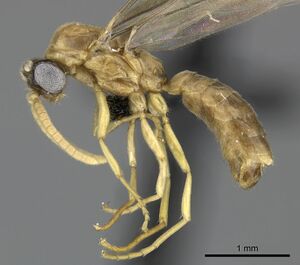     
| |
| Holotype of Adetomyrma aureocuprea. Male (alate). Specimen code casent0227991. Photographer Ryan Perry, uploaded by California Academy of Sciences. | Owned by CAS, San Francisco, CA, USA. |
 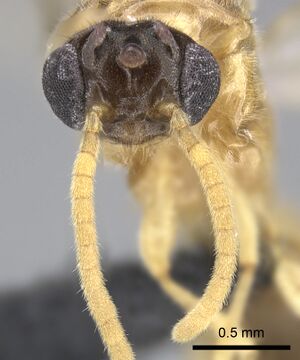   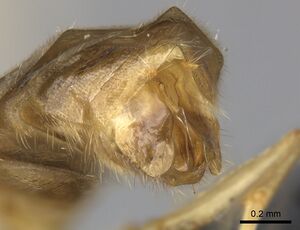  
| |
| Paratype of Adetomyrma aureocuprea. Male (alate). Specimen code casent0247003. Photographer Ryan Perry, uploaded by California Academy of Sciences. | Owned by CAS, San Francisco, CA, USA. |
      
| |
| Paratype of Adetomyrma aureocuprea. Male (alate). Specimen code casent0247004. Photographer Ryan Perry, uploaded by California Academy of Sciences. | Owned by NHMUK, London, UK. |
      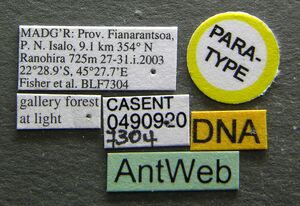
| |
| Paratype of Adetomyrma aureocuprea. Male (alate). Specimen code casent0490920. Photographer Ryan Perry, uploaded by California Academy of Sciences. | Owned by MHNG, Geneva, Switzerland. |
   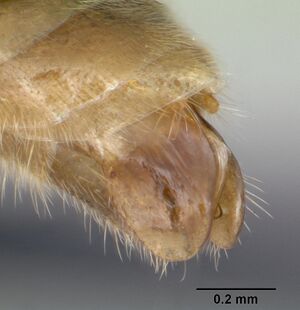  
| |
| Male (alate). Specimen code casent0490924. Photographer April Nobile, uploaded by California Academy of Sciences. | Owned by CAS, San Francisco, CA, USA. |
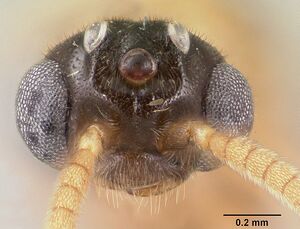     
| |
| Male (alate). Specimen code casent0143725. Photographer Dimby Raharinjanahary, uploaded by California Academy of Sciences. | Owned by CAS, San Francisco, CA, USA. |
Images from AntWeb
 
| |
| Male (alate). Specimen code casent0081395. Photographer Erin Prado, uploaded by California Academy of Sciences. | Owned by CAS, San Francisco, CA, USA. |
Nomenclature
The following information is derived from Barry Bolton's Online Catalogue of the Ants of the World.
- aureocuprea. Adetomyrma aureocuprea Yoshimura & Fisher, 2012b: 10, figs. 20, 28, 29, 38, 47, 56, 64 (m.) MADAGASCAR.
- Type-material: holotype male, 4 paratype males.
- Type-locality: holotype Madagascar: Fianarantsoa, Parc Nat. d’Isalo, 9.1 km. 354° N Ranohira, 22°28.9’S, 45°27.7’E, 725 m., 27-31.i.2003, BLF07304, gallery forest, at light (B.L. Fisher, C.E. Griswold, et al.); paratypes with same data.
- Type-depositories: CASC (holotype); BMNH, CASC, MCZC, MHNG (paratypes).
- Distribution: Madagascar.
Unless otherwise noted the text for the remainder of this section is reported from the publication that includes the original description.
Description
Male
Measurements: holotype. HL 0.57, HW 0.87, SL 0.16, EL 0.43, WL 1.42, MnW 0.9, CI 152.4, SI 18, EI 74.8, MnI 103.9.
HL 0.44–0.63, HW 0.59–0.91, SL 0.11–0.17, EL 0.3–0.45, WL 1.03–1.54, MnW 0.63–0.88, CI 135.6–145.7, SI 17.9–19.6, EI 67.4–75, MnI 97.1–106.3 (5 specimens measured).
Eye large and prominent, varied in size, but posterior margin not exceeding posterior margin of mid ocellus in full-face view. Distance between lateral ocellus and eye about same as diameter of lateral ocellus. Palpal formula 3,3 (three maxillary and three labial). Notaulus absent on mesoscutum. Parapsidal line usually unclear, sometimes weakly impressed but never pigmented with darker color. Anterior margin of petiole longer than dorsal margin in lateral view. Subpetiolar process not developed, without hairs.
Left and right parameres not overlapping or narrowly overlapping on dorsal small part of basimere. No distinct projection or lobe present on posterodorsal portion of paramere. Basal ring not reduced, covering whole anterior margin of paramere in lateral view. Basal projection on cuspis clear but not extraordinarily well developed. Aedeagus in lateral view: distal portion narrowed distal to ventral projection, apical margin relatively sharp, but without small projection on its posteroventral portion, posteroventral margin of ventral projection convex.
Hair on compound eyes short, about 0.25× diameter of mid ocellus. With mesofemur in dorsal view, anterior face with dense appressed hairs, and sometimes several longer subdecumbent hairs on basal portion. Ventral margin of eye not edged with darker pigment or punctures. Body bicolored, head brown and remainder yellow.
Type Material
Holotype. Male: CASENT0227991, BLF07304: MADAGASCAR, Fianarantsoa, Parc National d'Isalo, 9.1 km 354° N Ranohira, 22° 28.9´ S, 45° 27.7´ E, 725 m alt., gallery forest, at light, 27–31.i.2003, Fisher, Griswold et al. leg. California Academy of Sciences
Paratypes. 4 males: CASENT0247003 [CASC], CASENT0247004 The Natural History Museum, CASENT0490920 Musee d'Histoire Naturelle Genève, CASENT0490924 Museum of Comparative Zoology, with same data as holotype.
Etymology
This species name is derived from the Latin words aureus (golden) and cupreus (coppery), referring to the body coloration. The species epithet is treated as a noun in apposition, and thus invariant.
Determination Clarifications
This new species corresponds to the following species code used in previous studies: mgm05.
References
- Cantone S. 2017. Winged Ants, The Male, Dichotomous key to genera of winged male ants in the World, Behavioral ecology of mating flight (self-published).
- Yoshimura, M. & Fisher, B.L. 2012. A revision of the Malagasy endemic genus Adetomyrma (Hymenoptera: Formicidae: Amblyoponinae). Zootaxa, 3341, 1-31.
References based on Global Ant Biodiversity Informatics
- Yoshimura M., B.L. Fisher. 2012. A revision of the Malagasy endemic genus Adetomyrma (Hymenoptera: Formicidae: Amblyoponinae). Zootaxa 3341: 1-31.


